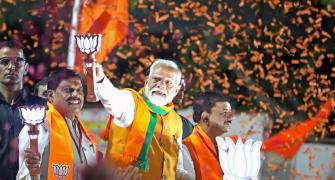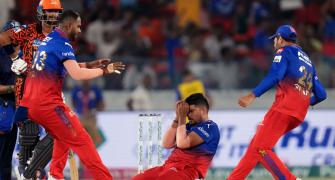Graeme Smith led South Africa's fightback in the third Test against India with an unbeaten 76 on Day 2 in Cape Town on Wednesday.
The Proteas skipper put on a stubborn 130-run unbroken second wicket partnership with Hashim Amla (50) after the loss of an early wicket to seize whatever initiative the visitors had gained by tea.
At stumps, replying to India's first innings total of 414, the hosts were a healthy 144 for 1.
The only South African wicket to fall was that of AB de Villiers (1), who inside edged S Sreesanth and was caught behind the stumps.
Earlier, despite half centuries from Sachin Tendulkar (60) and Sourav Ganguly (64), and a 50-ball 40 from Virender Sehwag, India were unable to swell their total as they lost their final five wickets for 19 runs.
Shaun Pollock claimed four wickets for 75 runs while debutant spinner Paul Harris picked 4 for 129.
Morning session:
India's job, at the start of the day, was two-fold: The team needed to bat through most of the day, to allow the baking sun to continue cracking up the wicket; it also needed to look to, at the least, double the overnight score before putting South Africa in to bat, in order to ensure that it could attack without worrying too much about losing the Test.
To accomplish both objectives, the first hour logically was the key: keep the South African bowlers at bay during that phase, when the hard roller, a bit of an overcast, a stiff breeze across the ground all combined to provide a modicum of help for the seamers, and from then on, the batsmen could dominate.
That gameplan came unstuck in the 8th over of the day, thanks to an interesting sucker punch from Dale Steyn. The first five deliveries seemed so much wasted effort: on the short side, for the most part, and wide enough outside off for VVS Laxman to leave on auto pilot. And then, the stunner: an express delivery around the 141 run mark, on the middle and off stump line on fullish length had Laxman half cock forward and in no position to cover the line. The ball hit the deck, bit, and seamed away just enough to slide past the outside edge and peg back the off stump (13/46; 269/4).
Sourav Ganguly came in and, like prime meat at a barbecue, straightaway took a tenderizing. A short one from Shaun Pollock cracked him on the knuckles; an over later, Steyn produced a short one that the batsman misjudged and ducked into; he was cracked a nasty blow on the temple, the ball deflecting off the glove and cracking him hard enough to warrant on field treatment. Drinks were called for while Ganguly's ear -- and equanimity -- were being restored; on the other side of the break, Steyn tempted the batsman with one angling away and Ganguly promptly came forward and creamed it through the covers. And when Steyn went around the wicket an over later and tried for the edge, Ganguly again came forward, to play the checked drive through point for a brace. Another bouncer, and this time Ganguly fended at it awkwardly, and watched as it looped just over the head of Hashim Amla at short square leg.
When the bowlers pitched anything length or better, though, Sourav was in his elements: easily forward, playing the push off the pads wide of midwicket or the punchy drives square or through covers on the off; one such drive, off Pollock in the 105th over of the innings, was a strong candidate for shot of the innings, thus far.
At the other end, Sachin Tendulkar was playing a different game -- firstly, against himself. Seemingly bothered by his recent tendency to find himself bowled or LBW by deliveries jagging back in from just outside off, Tendulkar took remedial action, first, by standing outside the crease by about a foot, and then by taking a middle stump guard and addressing the bowler with even his off stump almost entirely covered.
In practise, what the move ensured was that when the batsman went forward and across, his front foot was automatically outside the line of the off stump -- no way you could, even if struck, be given out LBW. Plus, the same factor ensured that there wasn't a gate for the ball to sneak through.
It also meant that deliveries angling in to off, which with the earlier guard would need to be played back down the track or out on the off, could be turned across to the on side.
Tendulkar spent some time testing the tactic out. When drinks were taken, he was on 37 -- an addition of 9 runs to his overnight score, all of them on the on: 2 to the fine leg region, 2 to square leg, one to midwicket and four to long on.
Noticeably, he used the changed guard only for Pollock and Ntini, the two bowlers who rely on bending the ball back in off the seam; against Steyn, whose deliveries almost exclusively go the other way, he switched to the more normal leg stump guard.
Ntini came back, was hit for an immaculate straight drive first up, and came within a toucher of hitting back when he made one stand up from length. Tendulkar was taken completely by surprise; only a last minute adjustment, taking his top hand off the handle, ensured the edge stayed out of the hands of second slip. The very next ball, of the 106th over, was picked smoothly off his pads through midwicket for the four that brought up his 50 (53/105 balls, 8 fours).
Paul Harris was brought back into the attack in the 107th over -- a somewhat surprising tactic from Smith, especially with Ganguly at one end. If Steyn (who came out to play with an unspecified injury, and left the field a half hour before lunch) and Pollock were tiring, you would have thought Smith would have let Kallis have a go -- the burly all rounder has the muscle to bounce the ball even off beach sand, and could have continued the premeditated attack on Ganguly.
Harris bowled over the wicket aiming for the rough; Tendulkar began the fun, shimmying down to pick a ball from outside leg and blast it past midwicket. With lunch approaching, Ganguly opted mostly for defense (he did try one of his patented dances down the track, but failed to get hold of the ball; the uppish lofted drive fell just short of Pollock at mid on, then beat the fielder and rolled over the fence). He however showed no such restraint against Ntini, creaming him for two boundaries in the 110th over -- the first a flick of the hips to the backward square leg fence; then an early read of a short ball and a comfortable squat under it; then picking another short one early enough to move fluidly into position and pull in front of square. When Ntini began his next over with a shortish ball closer to off stump, Ganguly -- who by then had clearly made up his mind to fight fire with fireworks -- rocked back and thumped it through point for a third four in the space of seven balls (Tendulkar, later in the over, rubbed it in with a little shuffle to change Ntini's line, followed by a punch back past the bowler).
Lunch was less than ten minutes away; India seemed to be surging ahead on the spate of good strokeplay primarily from Ganguly -- and then Harris struck. Tendulkar, yet again, got out to a rookie -- though for once, the ball deserved the wicket. It was almost Warne-like in execution: floated, hitting the rough outside leg, then bouncing and turning sharply to hit the defensive bat high, and go through to Kallis at slip (64/130 balls; 11 fours; India 337/5). For the second time in two Tests, Tendulkar had done the hard yards and departed just when he seemed to have the bowling at his mercy; the wicket, what is more, fell at the worst possible moment, with lunch around the corner.
Virender Sehwag started with a checked drive off Harris for a single to get off the mark; at the other end, Ntini greeted him with a bouncer and Sehwag said hello back, first with a crackling square cut through point, then a flick off the hips through midwicket for successive fours.
At lunch, despite the loss of two wickets, India still had the upper hand -- barely. The scoring rate through the morning session was close to the four runs an over mark; the 63-run stand between Tendulkar and Ganguly had made up for the early loss of Laxman; Ganguly looks increasingly set; the ball has lost its shine and hardness; a good score is in place and if Sehwag can fire in tandem with his one time captain, India can push on to the sort of score it needs to take charge of the Test. Against that, South Africa needs just the one wicket, to get into the tail; if it can bowl India out for under the 400 mark and follow that up with a good batting performance, it will still fancy its chances in the second innings, on a deteriorating pitch.
Lunch time score: India 350/5 in 115 overs; Sourav Ganguly 24/37; Virender Sehwag 12/13; India 96 runs in the session off 25 overs for the loss of Laxman and Tendulkar.
Post-Lunch session:
Before start of play this morning, India coach Greg Chappell in a spot chat with Star Plus (these pre-play chats with the two coaches are proving an interesting add on to the coverage, giving you an admittedly varnished, packaged view into the thinking of the two teams) was asked what he thought was a total India would be happy with.
400, he said. Surprisingly modest ambition, I thought at the time, considering the position India was in -- wouldn't you want another 50, preferably 100?
If that is indicative of the team's thinking, it is interesting: yes, there is something in this wicket for the spinners, but India only has one, albeit there are few better crumbling-track bowlers than Anil Kumble. There is, however, no real indication that the track will equally aid India's seamers, so 400 seemed a touch underwhelming, given the imperative of not batting again on this deck.
The way the two not out batsmen played on resumption, it looked like the gameplan was to get to that total in a heck of a hurry. Virender Sehwag, who in the over after lunch survived a huge shout for LBW (the ball, Hawkeye subsequently confirmed, was going over the stumps) off Shaun Pollock, was clearly the designated hitman: the first ball Harris bowled saw the batsman down on one knee, waiting, then smashing through midwicket. At the other end, he drove Pollock through the covers, then late cut him to the third man fence. In between Ganguly, not to be left out, played a neat dab to third man, also off Pollock, and suddenly runs were leaking at both ends.
Ganguly settled down to use the singles to good effect; Sehwag continued to hit. In the 123rd over, he again went down on one knee to swing Harris against the turn, this time hitting higher than his first effort, and comfortably clearing the midwicket fence. An over later, he came running down the track and drove inside out, high over long off for a boundary.
Pollock and Ganguly meanwhile were playing a game of their own. The bowler produced a good bouncer that Ganguly left with increasing signs of confidence, then followed it with the sucker ball, full and wide; Ganguly drove at it, the ball got the edge, but there was no third slip to take advantage and the four to third man got the batsman to a very good 50 (60 balls, 8 fours), particularly commendable for the way he fought back after being repeatedly hit in the first few minutes of his tenure.
Sehwag's assault ended, however, in the next over -- once too often he went down on his knee to slog-sweep Harris, but this time the ball was shorter in length, and Sehwag only managed to get the toe of the bat on it, scooping the ball in the air for Makhaya Ntini, running in from the square leg fence, to dive full stretch forward and hold as the ball was dropping on him (40/50; 395/6; the 6th wicket partnership worth 58 at 4.7).
The end came swiftly, from that point on. Pollock set up Anil Kumble with a couple of straight deliveries, then bent one back in to pin him in front (0/3; 395/7).
The next dismissal, by Mark Boucher, was brilliant, or incredibly lucky -- depends on your point of view. Harris beat the batsman with a quicker delivery; Zaheer Khan was reaching a long way forward to try and flick; he was beaten but the toe was well in. Boucher collected and reflexively took off the bails -- and as luck would have it, at precisely that moment in time, Zaheer's toe rose an inch off the ground as he fought for balance. Bottomline, man overboard (1/12; 398/8).
Sreesanth smashed Pollock for a brace through the covers, but was squared up next ball by a delivery that angled in to him, then seamed the other way to find the edge through to Gibbs in the gully (3/5; 407/9).
With partners disappearing like dew at daybreak and the very real prospect of ending the series as he had begun it -- unbeaten -- facing him, Ganguly waltzed down to Harris and played one of his patented shots: an effortless loft over long on that makes the ball travel impossible distances with seemingly minimal effort. Pollock, however, foxed him with the slower ball; Ganguly gave him the charge, was beaten, and could only scoop it up for Amla to run behind the bowler's back and hold (66/75 balls).
For South Africa, the stand out performers were Harris and Pollock. The former, on debut, bowled tirelessly; he started out looking quite ordinary, but once he discovered a bit of rough outside the right hander's leg stump and switched to over the wicket, the southpaw spinner began looking like a veteran. Pollock, too, started off somewhat tetchy, getting involved in mid pitch clashes with Ntini and then his captain, but steadied himself, and bowled immaculate lines; every one of his wickets was mind over matter.
India all out 414; the total the team seemingly wanted, though on balance you had to say that on this pitch, and given the start they enjoyed, India could -- should -- have aimed for 75-100 more. When the last Indian wicket fell, 44 overs remained in the day, plus three full days to follow. That on the surface lets SA get a foot in the door -- bat well and deep, push on to a score of 550 or so by afternoon of day four and who knows; India batting third on a wearing pitch behind by 150, and things could happen.
Talking of things happening -- Graeme Smith launched a hook at the first ball of the innings, from Zaheer Khan, and top edged it over fine leg for six to get things going. Zaheer ended the over with another bouncer and this time, Smith controlled the pull, and hit the boundary in front of midwicket to have SA 10/0 after just one over.
Sreesanth -- who around now must be thinking Test cricket is a pretty easy day job -- shrugged off the benign nature of the pitch (from a seamer's perspective, that is) and got the early breakthrough. The ball was fuller in length, inviting the drive; it cut back in sharply off the seam, found the inside edge of de Villiers' bat, and Dinesh Karthick held (1/13; SA 14/1).
That was only the fourth over of the innings; at the other end, Smith looked up and found Anil Kumble already into the action -- around the wicket to exploit the rough -- after just two overs by Zaheer Khan. Things began happening: Smith edged a drive past point; Amla pushed, got the thick edge, and found the ball just eluding a diving Laxman in the slips; another ball bit the deck, turned, bounced and had the batsman stranded... and on cue, the chirping calls of 'Come on Anil, good one Jumbo' kicked into high gear.
By the time this Test is over, we are likely to get sick of hearing that.
Sreesanth's confidence is clearly sky high. The first ball of his third over was a superbly disguised slower ball, the first one we have seen him bowl all series; Smith was clearly foxed, and hit on the pad; only the fact that the ball landed just outside line of leg before homing in to the stumps saved him from the LBW. He then tried the sucker ball, wide of off, and Smith went for it and was beaten. The next ball squared the SA captain up, hitting line of middle then leaving the left hander late. Smith got a bit of his own back when a bit of extra width let him slash the four through point.
Smith and Amla played out one more Kumble over, and at tea, South Africa were 25/1 with Smith 21/22; Amla 3/7, in 7 overs. 40 overs remain in the day; one suspects that India might go conventional with pace at either end after tea, but given the conditions, you can expect Kumble to be bowling a bulk of those overs. Coming up, the make or break session for both sides.
Post-Tea session
There was this point in the Indian innings, when Sachin Tendulkar turned a ball off his pads, with such timing the commentators called it a four.
And then, into the frame hurtled Ashwell Prince, rocketing from midwicket, hunting down the ball and hurling himself headlong, arms outstretched and reckless of life and limb, to pull the ball back and save one run.
Sunny Gavaskar, in the expert's chair at the time, called it foolhardy; the fielder, he said, could have seriously injured himself, and all for the sake of one run.
Neither Sunny nor anyone else would have had cause for such complaints while watching the Indians in the post-tea session: the fielding, at its very best in Johannesburg, was at its very worst here. Fielders ambled along behind the ball, dived over it, around it and even under it, rarely gave committed chase...
The reason this vignette comes upfront? Pressure.
In the first innings, the South African seamers even in unhelpful conditions kept India from breaking loose through their fielding, which backed the bowlers up, cut off certain boundaries, and generally kept up the pressure when the bowlers couldn't. When India bowled, the reverse was true; even edges off good deliveries got runs, the strike was rotated with ease, and the two batsmen flourished, each in his own fashion.
Graeme Smith was the more impressive. He was not one hundred per cent in control, but he played the waiting game to perfection, cashed in on any errors in length and line, played some fluent shots on both sides of the wicket, and generally led from the front with the bat.
For a bloke who has been out of form, Smith has done well for himself -- this session saw him become the second youngest batsmen in Test history to the 4000 run mark, behind only Sachin Tendulkar. The pick, from a bouquet of authoritative shots, were the two on drives he played in successive overs off Anil Kumble when the leg spinner got his first bowl of the session. Both shots were perfectly executed; cumulatively, they put Kumble on notice that he was not going to be able to run in and bowl them over.
At the other end, Hashim Amla profited from his captain, who initially farmed the strike to let the youngster settle his nerves. Once his eye was set, Amla played the conditions well, eschewing anything extravagant, batting in very straight lines and playing the percentages with a grim determination to come good.
From an Indian point of view, the first plot point was the introduction of Munaf Patel, getting his first bowl of the series in the 15th over of the innings. Munaf ran in very gingerly, not pounding the ground in his run up and delivery stride; clearly, he was not yet fully confident of his damaged limb. It took a while for the bowler to settle in; it was only past the 25th over, when first Zaheer Khan, then Munaf, got the ball to reverse that the latter began looking like the bowler who, not so long ago, was taking the likes of Brian Lara out for fun.
For his part, Kumble made the odd ball jump and turn, but for the most part, bowling into a very strict breeze, the leggie bowled flat and quick, hustling the batsman but at the same time not really giving the ball a chance to hit the cracks and talk in tongues. It also didn't help that the really dusty part of the pitch is outside the right hander's leg stump, not an area Kumble, who homes in on middle and off as a rule, is prone to hit.
South Africa's 100 came up in the 30th over of the innings, a healthy rate of 3.91.
The Indian bowlers were slowly discovering what the Proteas had over two three heartbreaking sessions on the first day: bowling on this track takes the patience of a saint, and then some. It is in this department that the Indian bowlers lacked, on the day -- they were too eager to make things happen, too full perhaps of happiness after the team topped 400 for the first time this series, that rather than stick to a line, they sent down assorted all-sorts and played right into the hands of two batsmen who were willing to sit on the fence, poised to jump on any error with both feet.
An uppish flick off Sreesanth, just wide of Jaffar at midwicket, got Amla to his 50 (125 balls) -- a knock of exemplary patience. The last few overs of the evening were in fact enlivened by a mini contest between Sreesanth and Amla, with the bowler trying everything from verbals to some bizarre run ups to upset the batsman and Amla hanging on to his wicket with focussed intent.
India made one final throw of the dice for the day in the 41st over, when Sehwag was given the ball; the off spinner promptly went around the wicket looking for the rough around Smith's off stump, with slip, gully and silly point in wait, and produced a probing, testing first over. That over in fact brought play to an end with five overs to bowl -- tardy over rates had ensured that India was behind on that count.
At stumps, South Africa, on 144/1 after 41 overs, were 270 behind on the first innings with nine wickets in hand.
Overall, the Proteas fought their way right back into the match; the session clearly belonged to the home side. For both sides, much hard work lies ahead: there are 270 overs left in the game, and at this point, the game is there for the team with the bigger heart and greater cricketing nous to crack wide open.








